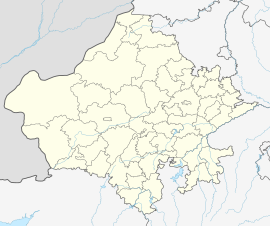
Back كاليبانجان ARZ Калібанган Byelorussian Kalibangan German Kalibangan Spanish Kalibangan Finnish Kalibangan French कालीबंगा Hindi カーリバンガン Japanese ಕಾಲಿಬಂಗಾ Kannada Kalibanganas Lithuanian
 The western mound of Kalibangan, known as the Citadel | |
| Location | Rajasthan, India |
|---|---|
| Region | Thar desert |
| Coordinates | 29°28′27″N 74°7′49″E / 29.47417°N 74.13028°E |
| Type | Settlement |
| History | |
| Abandoned | Around the 20th or 19th century BCE |
| Periods | Harappan 1 to Harappan 3C |
| Cultures | Indus Valley civilization |
Kalibangān is a town located at 29°28′N 74°08′E / 29.47°N 74.13°E on the left or southern banks of the Ghaggar (Ghaggar-Hakra River)[1][2] in Tehsil Pilibangān, between Suratgarh and Hanumangarh in Hanumangarh District, Rajasthan, India 205 km from Bikaner. It is also identified as being established in the triangle of land at the confluence of Drishadvati and Sarasvati Rivers.[3] The prehistoric and pre-Mauryan character of Indus Valley civilization was first identified by Luigi Tessitori at this site. Kalibangan's excavation report was published in its entirety in 2003 by the Archaeological Survey of India, 34 years after the completion of excavations. The report concluded that Kalibangan was a major provincial capital of the Indus Valley Civilization. Kalibangan is distinguished by its unique fire altars and "world's earliest attested ploughed field".[4] It is around 2900 BC that the region of Kalibangan developed into what can be considered a planned city.[5]
Kalibangan was first excavated under the Directorship of B. B. Lal (ASI) between 1960-61 to 1969-70. Other excavation team members were B.K. Thapar, M.D. Khare, K.M. Shrivastava and S.P. Jain.
- ^ Calkins, PB; Alam M. "India". Encyclopædia Britannica. Retrieved 31 December 2008.
- ^ Lal, BB (2002). "The Homeland of Indo-European Languages and Culture: Some Thoughts". Purātattva. Indian Archaeological Society. pp. 1–5.
- ^ McIntosh, Jane (2008) The Ancient Indus Calley : New Perspectives. ABC-CLIO. p. 77
- ^ Lal, BB (2003). Excavations at Kalibangan, the Early Harappans, 1960–1969. Archaeological Survey of India. pp. 17, 98.
- ^ Kulke, Herman (2004). History of India. Routledge. p. 25. ISBN 9780415329200.

